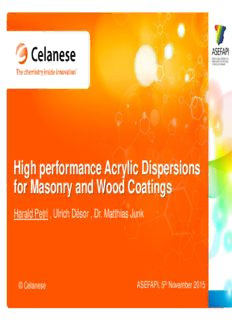
High performance Acrylic Dispersions for Masonry and Wood Coatings PDF
Preview High performance Acrylic Dispersions for Masonry and Wood Coatings
High performance Acrylic Dispersions for Masonry and Wood Coatings Harald Petri , Ulrich Désor , Dr. Matthias Junk © Celanese ASEFAPI, 5th November 2015 Agenda ► Polymer Dispersions – Basic Knowledge ► Homogeneous Acrylic Dispersions ► Advanced Polymerization Technologies ‒ Core/Shell -Technology ‒ New Gradual Composition (GC) –Technology from Celanese ► Application Test Results ► Summary © Celanese High performance Acrylic Dispersions 2 What is a Polymer Emulsion ? ( in fact : Polymer Dispersion ) Synonym Water Homogeneous Medium Polymer-Dispersion Polymer Colloid Polymer Particle Latex Heterogeneous Medium „Polymer-Emulsion“ A polymer dispersion consists of very small polymer particles distributed in the homogeneous phase water © Celanese High performance Acrylic Dispersions 3 Structure of a polymer particle Polymer Properties - chemical composition - glass transition temperature (Tg) - degree of crosslinking - molecular weight Colloidal Properties - emulsifier, type, amount - number of sphere charges - number of charges in serum A polymer particle is composed of a „polymer core“ and a colloidal „shell“ which has a strong impact on workability © Celanese High performance Acrylic Dispersions 4 Film formation Phase I Evaporation of water Proper film formation only Phase II Deformation of particles occurs if ambient temperature is above MFFT ! Phase III Coalescence Phase IV Interdiffusion of polymer chains Proper film formation needed to obtain a robust polymer film © Celanese High performance Acrylic Dispersions 5 Film formation Minimum Film Formation Temperature ( MFTT ) 0°C Temperature Gradient 20°C MFFT 0°C 18°C >20°C MFFT – Bench The Minimum Film Formation Temperature ( MFFT ) is the lowest temperature required to obtain a polymer film without any defects. MFFT can vary from 0°C ( freezing water ) to 100°C ( boiling water ) ! © Celanese High performance Acrylic Dispersions 6 Polymer hardness Glass Transition Temperature ( Tg ) Tg of Polymer Film 100 oC 25 oC -100 oC stiff and briddle leather-like tacky Plastic Coatings Masonry Coatings EWC ( Pure Acrylic ; Tg = 98°C ) ( Pure Acrylic ; Tg = 23°C ) ( Pure Acrylic ; Tg = -30°C ) Fibre Cement Coatings Masonry Coatings ( Pure Acrylic ; Tg = 48°C ) - low emission - ( Pure Acrylic; Tg = 6°C ) below Tg : Polymer chains like above Tg : Polymer chains like uncooked Spaghetti ( rigid ) cooked Spaghetti ( flexible ) © Celanese High performance Acrylic Dispersions 7 Correlation between MFFT and Tg 30 25 ) C ° 20 ( Tg = MFFT Styrene-Acrylic T 15 F F M 10 VAE 5 0 6 8 10 12 14 16 18 20 22 24 26 28 30 32 34 T (°C) g MFFT correlates with Tg in many cases, but is not the same. Tg ≈ MFFT for hydrophobic polymers ( e.g. Styrene/Acrylic ). MFFT can be lowered by adding suitable solvents and/or coalescing agents. For hydrophilic polymers ( e.g. VAE ) water can act as coalescing agent ( Hydroplastification ). Heterogeneous dispersions could have more than one Tg whereas every dispersions has only one MFFT. © Celanese High performance Acrylic Dispersions 8 Film Forming Process of homogenous Polymer Dispersions ( „soft “ vs. „hard“ ) Lowering of MFFT by adding suitable coalescent agents MFFT /Tg Production [ °C ] Hard Polymer Film 40 ‘hard’ Evaporation of Dispersion coalescent agents 30 Addition of coalescent agents 20 typical ambient Application Drying ‘soft’ temperature 10 Storage Dispersion Soft Polymer Film 0 time © Celanese High performance Acrylic Dispersions 99 Combining opposing properties Film forming without any addition of To achieve a better polymer hard- ? coalescent agents requires a “soft” ness ( low blocking ) especially at polymer dispersion and thereby a high temperatures “hard” polymer relative soft polymer film hardness. dispersions are required. Low Glass Transition High Glass Transition Temperature (Tg) Temperature (Tg) Advanced Polymerization Technologies – Best of both worlds Optimizing the balance between Soft Polymer Phase ( low Tg ) and Hard Polymer Phase ( high Tg ). Soft phase enables the film forming at lower temperatures and reduced demand of coalescing agents whereas the high Tg phase improves film hardness and block resistance. © Celanese High performance Acrylic Dispersions 10
Description: